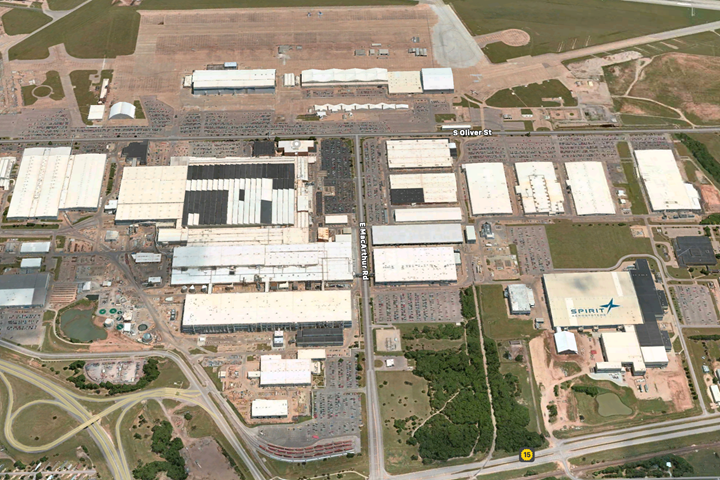Spirit AeroSystems reports third quarter earnings
Although Spirit’s revenues declined 58% in the quarter compared to third quarter 2019, CEO Tom Gentile says the company anticipates steady growth going forward as the 737 MAX returns to service.

Spirit AeroSystems’ Wichita, Kan., U.S., campus aerial view. Photo Credit: CW
Tier 1 aerospace and defense manufacturer Spirit AeroSystems (Wichita, Kan., U.S.) reported its third quarter 2020 earnings on Nov. 3. Although the pandemic and the Boeing 737 MAX grounding have cut substantially into Spirit’s revenues, the company says it expects earnings to increase through the end of 2020 and throughout 2021.
Spirit’s third quarter revenue was $806 million, down from $1.92 billion in third quarter 2019. Earnings per share were $1.50, compared to $1.38 in the same quarter last year. The company delivered 15 737 shipsets in the quarter, compared to 154 a year ago. Spirit also delivered 206 shipsets for all programs in the quarter, compared to 437 a year ago.
To adjust to this loss, Spirit has laid off 8,000 employees and closed its McAlester, Okla., U.S., manufacturing facility and consolidated those operations into other locations. The company also secured $900 million in new debt. As previously reported, on Oct. 30 Spirit closed its acquisition of Bombardier Aerospace facilities in Belfast, Northern Ireland, Casablanca, Morocco, and Dallas, Tex., U.S. Spirit paid $275 million for the Bombardier facilities; the original purchase price had been $500 million.
The Bombardier acquisition expands Spirit’s reach in the MRO and aftermarket segments, which Spirit says will help diversify its portfolio considerably. The Belfast facility also fabricates the infused composite wing for the Airbus A220 single-aisle aircraft and is seen as a significant jumping-off technology for next-generation aerostructures development. Tom Gentile, CEO of Spirit, said the company would spend considerable time at the Belfast plant, looking for opportunities to reduce waste and optimize manufacturing of the composite wing. Read here for more on the Belfast operation.
Going forward, Gentile says Spirit anticipates a gradual increase in revenues, with a return to positive free cashflow by 2022, assuming the Boeing 737 MAX is soon re-certified and re-enters service. Although Spirit fabricates parts for almost every major commercial aircraft program in the world, it manufactures the most for the 737, including the fuselage, pylon, wing leading edges, thrust reversers and engine nacelles. Boeing has said it expects to ramp 737 MAX production up to 31 planes per month by 2022. Gentile did note that Spirit has 128 737 shipsets on hand that it needs to work through.
Gentile says the only headwind Spirit expects to face in the coming years is in widebody production, which likely will feel the pandemic-induced air travel depression longer and more deeply than narrowbody aircraft will. Spirit makes the forward composite fuselage for the Boeing 787, production which is being reduced from 14 per month to six per month in 2021. Similarly, Gentile says the production rate of Airbus A350, for which Spirit makes composite fuselage panels and wing components, is expected to drop to 4.5 shipsets per month by 2021.
Related Content
-
US Air Force selects Integris Composites ballistic body armor
Cratus Wave armor is thin, lightweight and reduces heat stress, providing buoyant personal protection for the 582nd Helicopter Group.
-
Large-format 3D printing enables toolless, rapid production for AUVs
Dive Technologies started by 3D printing prototypes of its composite autonomous underwater vehicles, but AM became the solution for customizable, toolless production.
-
Industrializing additive manufacturing in the defense/aerospace sector
GA-ASI demonstrates a path forward for the use of additive technologies for composite tooling, flight-qualified parts.
















